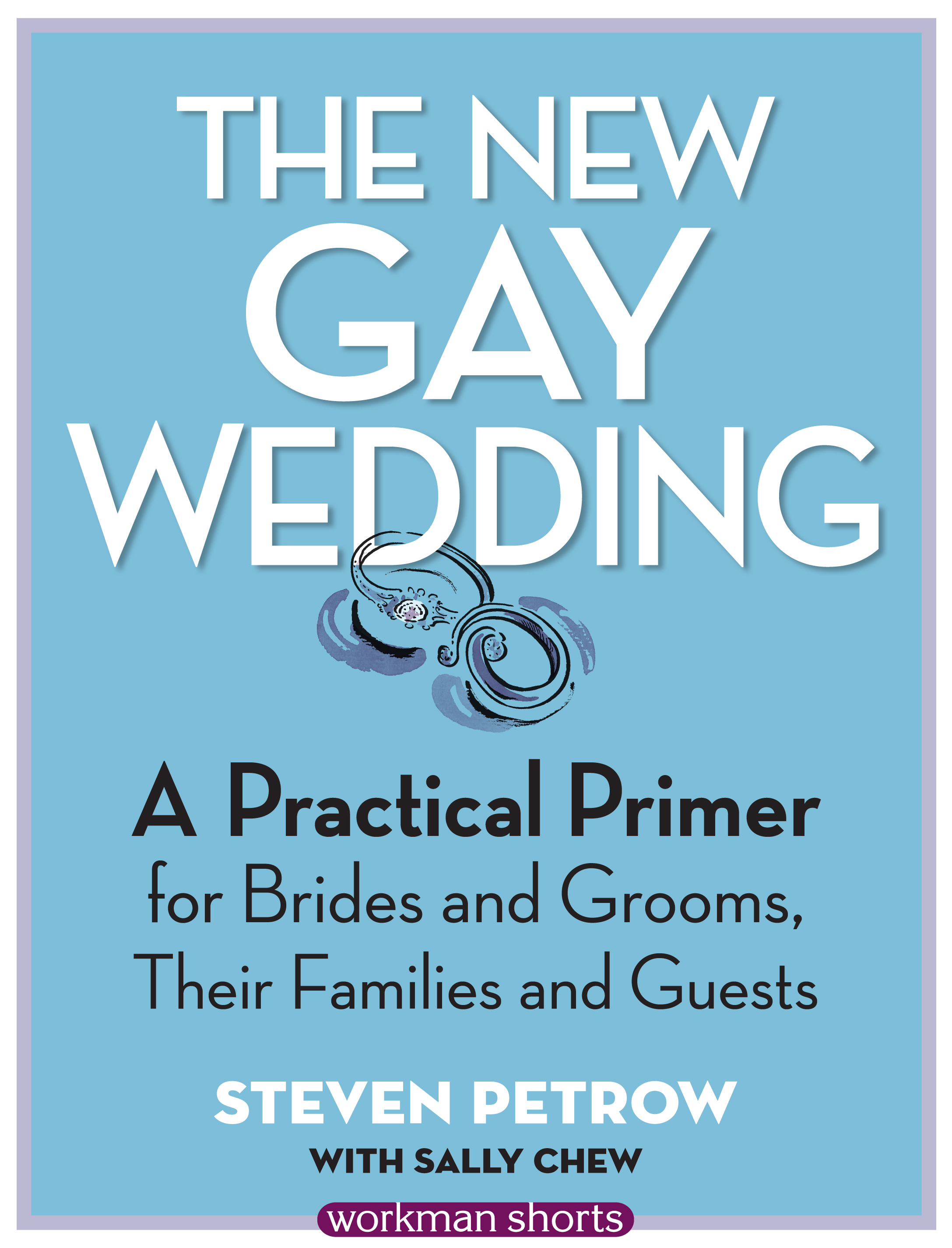 Times have changed -- and with them, so have the rules. Just published as an original e-book, The New Gay Wedding: A Practical Primer for Brides and Grooms, Their Families and Guests is for anyone planning (or invited to) an LGBT wedding or commitment ceremony, covering what to call the event, who pays for what, and the right way to word a same-sex wedding invitation. From the nitty-gritty (what are your state's requirements for making it legal?) to the fun and pretty (what to wear!), The New Gay Wedding is a handy, one-stop shop for gay couples planning their big day. Read an excerpt below:
Times have changed -- and with them, so have the rules. Just published as an original e-book, The New Gay Wedding: A Practical Primer for Brides and Grooms, Their Families and Guests is for anyone planning (or invited to) an LGBT wedding or commitment ceremony, covering what to call the event, who pays for what, and the right way to word a same-sex wedding invitation. From the nitty-gritty (what are your state's requirements for making it legal?) to the fun and pretty (what to wear!), The New Gay Wedding is a handy, one-stop shop for gay couples planning their big day. Read an excerpt below:
Making the Ceremony Your Own
You can personalize a ceremony in many ways, from the choice of readings and the wording of your vows to the type of music, from the blessing offered by your officiant to how you involve your guests and even what you choose to wear. All these small decisions add texture and personality to a ceremony and make it your own. While many LGBT couples follow well-established religious or straight wedding traditions, others of us choose to be less formal, more activist, or even whimsical. In the end, you're constrained only by your creativity, your budget, and, of course, any rules that a specific venue may impose.
Weddings with an LGBT Twist
Some LGBT couples making a public commitment to each other want the fact that they're gay or transgender to speak especially loud. There are endless ways to include statements about your LGBT lives or current politics into your ceremony -- beyond the sheer fact of your union. An American lawyer married his British lover in England because they would be conferred with so many more rights and benefits, which were read aloud during their ceremony. The Midwesterner reports, "For my many American straight friends, it had never quite dawned on them in such a powerful way just what we as a society lose for being gay; and to hear that in the context of a very traditional wedding -- except for the fact of two grooms -- politicized many of them."
Here are other ways to add LGBT touches to your ceremony:
- In your vows, talk not only about your love for each other, but the struggle for our right to marry in every state. If you can't legally marry in your state, make note of that.
World Traditions
LGBT weddings often incorporate a mix of cultural and ethnic traditions, whether as a small part of the ceremony or as the centerpiece of the celebration. Some couples draw on their own heritages, while others borrow symbolic elements that have particular meaning for them. These may include specific rituals, like the Hindu tradition of creating a fire in the center of the wedding altar as an offering, or variations on the Jewish tradition of couples standing under a chuppah or canopy and stomping on a wineglass wrapped in cloth to symbolize the fragility of love.
A beloved African-American wedding tradition involves jumping over a broom to honor the families of slaves, who weren't allowed to marry, while Chinese couples often serve each other's families tea in a special ceremony. Your wedding ceremony can be as inclusive of these and other ethnic traditions as you like, although be sure to take note that many of these rituals have gender-specific elements that need to be creatively adapted by LGBT couples.
Other world traditions to consider include
- The signing of the ketubah, a marriage contract central to the Jewish faith, which is often read by the rabbi during the ceremony.
Wedding Vows
Vows remain the cornerstone of any wedding ceremony. Whether that means simply answering "I will" to the preset vows of your church or spiritual home, adjusting those words to your liking, or proclaiming your love and devotion in your own words, vows highlight the spiritual, religious, or legal commitment being made by marrying or partnering. The ring exchange then comes to symbolize what you've just proclaimed to each other in front of all your guests, who support your union and celebrate it with you. No matter what words you finally decide to say, vows are a public affirmation that you will be with each other, from this day forward.
Writing Your Own
Choosing the words for your own wedding vows provides yet another opportunity to personalize your ceremony. Perhaps the most common way to approach vow-writing is for each partner to look inward and come up with language of his own to describe his experience of love, commitment, and respect. It's best if this language has some meaning to your partner as well as to your assembled friends and family members.
For many, this process doesn't come easily. How to put in words a set of feelings that perhaps you can't even describe to yourself? Sometimes it helps to start with something standard and adapt it as you see fit. "We asked the officiant to send us different sets of vows that other [straight] couples had used," said one recently married gay man. "We gave her suggestions and then added our own statements to her more-or-less standard format." There are also a number of questionnaires found online that can help guide you through the process of creating your own vows, as well as examples of vows used by LGBT couples. Religious and professional officiants can also guide you to relevant examples.
If you're planning on writing your own vows:
- Keep Them Brief: This is not the time to recount how you met or the ups and downs of your relationship. Focus instead on the commitment you're making to each other.
Ceremony Readings
A romantic poem or other favorite text read aloud during the ceremony can complement your vows, delivering a particular message or evoking a full spectrum of emotions. A friend, a family member, or the officiant may recite these texts. There's an almost infinite range of sources to borrow from, including the Bible, a favorite children's story, poetry, prose, song lyrics, or a passage from a book that has personal, religious, or family significance. Inviting others to read is also a gracious way to make your guests feel part of the ceremony. Ask a child to read a poem, an aunt to recite her favorite Psalm, or your best friend to read a sonnet that has meaning to you. If a member of the wedding party has a beautiful voice, perhaps she can perform the tune that you and your partner have come to regard as "your song."
Seating Arrangements at the Ceremony
At informal weddings, guests usually take whatever seats are available, although it's wise to mark off the front rows for your closest friends and family members. (This is easily done with a ribbon.) If yours is an old-school wedding, especially one taking place in a church, it's traditional to divide up the room by family, putting each of your parents up front on a center aisle, with other relatives alongside and behind them. This approach may not speak to your own needs and guests, especially since many of the guests are likely to be equally close to both of you (so don't let your friends get hung up on choosing sides).
Nevertheless, here are a few timeless tips and modern adaptations that are worth considering at LGBT weddings:
- Use ushers to bring guests to their seats if you can. Designating a few friends, male or female, for this task is a nice touch and will help your guests feel welcome and connected. The ushers should also be familiar with any seating plans you may have drawn up. Typically, ushers offer a crooked right arm to female guests or anyone needing extra assistance and walk them to their seats. But if you'd like equal treatment for your male guests, go ahead. If there's a program for the service, your ushers hand them out.
This e-book is adapted from Steven Petrow's Complete Gay & Lesbian Manners, which was just nominated for a Lambda Literary Award.
Steven Petrow is the author of Steven Petrow's Complete Gay & Lesbian Manners and can be found online at www.gaymanners.com. Got a question? Email him at ask@gaymanners.com, or contact him on Facebook and Twitter.
